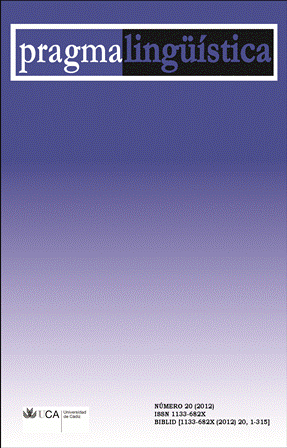Middle sentences: An argument for conceptual structure

DOI
https://doi.org/10.25267/Pragmalinguistica.2012.i20.04Información
Resumen
Middle sentences in English are only partly described within the Government and Binding theory. Some semantic and discourse generalizations which are integral to the meaning of these constructions are just set aside, if they are mentioned at all. The theory of conceptual semantics developed by Ray Jackendoff (1983, 1987, 1990) presents the first viable alternative to the syntactic strategies descending from Chomsky’s theory. In this paper I will examine the middle voice and show how several Government and Binding analyses of these constructions fail to account for important parts of the data. I hope to persuade the reader that a conceptual structure analysis of this phenomenon provides a more appealing solution which fully integrates the syntactic and semantic generalizations.
Palabras clave
Descargas
Cómo citar
Licencia
Derechos de autor 2018 Pragmalingüística

Esta obra está bajo una licencia internacional Creative Commons Atribución-NoComercial-CompartirIgual 4.0.
Citas
CARRIER, J. & J. RANDALL (1988): "From conceptual structure to syntax: projecting from resultatives", unpublished paper, Harvard University and Northeastern University.
FAGAN, S. M. B. (1988): “The English middle”, Linguistic Inquiry 19, pp. 181-203.
GRUBER, J. (1965): Studies in lexical relations, Doctoral dissertation, Cambridge, Massachusetts, MIT.
HALE, K. & J. KEYER (1987): “A view from the middle”, Lexicon project working papers 10, Cambridge, Massachusetts: Center for Cognitive Science, MIT.
JACKENDOFF, R. (1983): Semantics and cognition, Cambridge, Massachusetts: The MIT Press.
JACKENDOFF, R. (1987): “The status of thematic relations in linguistic theory”, Linguistic Inquiry 18, pp. 369-411.
JACKENDOFF, R. (1990): Semantic structures, Cambridge, Massachusetts: The MIT Press.
KEYSER, S. J. & T. ROEPER (1984): “On the middle and ergative constructions in English”, Linguistic Inquiry 15, pp. 381-416.
PERMUTTER, D. M. (1978): “Impersonal passives and the unaccusative hypothesis”, Proceedings of the fourth
annual meeting of the Berkeley Linguistics Society, pp. 157-189.
ROBERTS, I. (1987): The representation of implict and dethematized subjects, Dordrecht: Foris.
Van OOSTEN, J. (1977): “Subjects and agenthood in English”, Chicago Linguistics Society 13, pp. 459-471.
WILLIAMS, E. (1981): “Argument structure and morphology”, The Linguistic Review 1, pp. 81-114.






